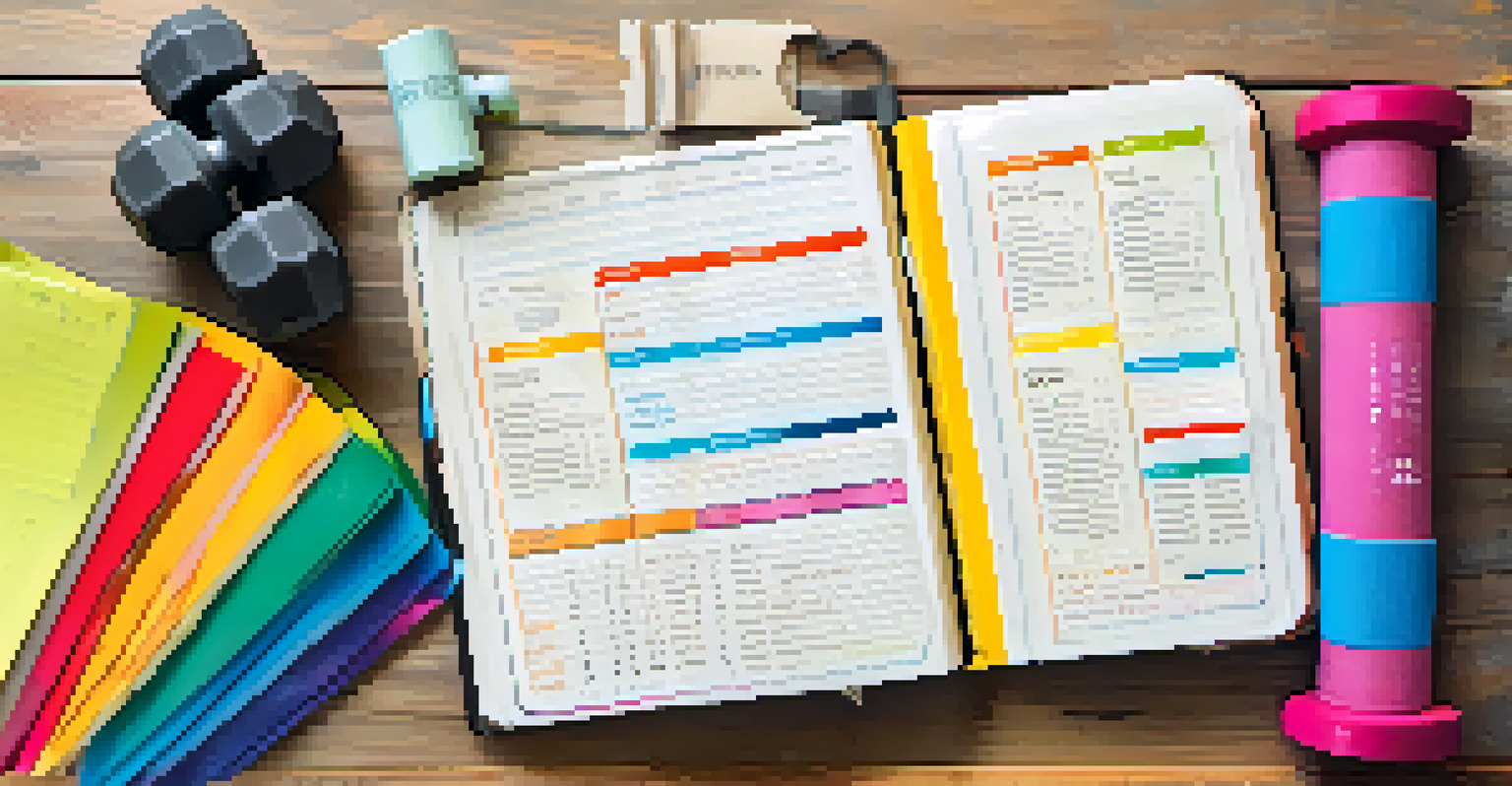Realistic Goal Setting: Balancing Workout and Recovery

Understanding the Importance of Goal Setting
Setting realistic goals is crucial for anyone looking to improve their fitness. It helps you maintain focus and motivation while making the journey less overwhelming. When goals are clear and attainable, you're more likely to celebrate small victories along the way, which boosts your confidence.
Setting goals is the first step in turning the invisible into the visible.
Think of goal setting as your roadmap to success. Just like a driver needs a map to reach a destination, you need specific goals to navigate your fitness journey. Without them, you might find yourself wandering aimlessly, unsure of what steps to take next.
Moreover, realistic goals help you manage your expectations. It’s about understanding your current capabilities and gradually pushing your boundaries. This way, you avoid burnout and injuries, making your fitness journey sustainable.
Identifying Your Fitness Priorities
Before setting goals, take a moment to identify what matters most to you. Are you aiming to build strength, lose weight, or improve endurance? Knowing your priorities will help you tailor your goals and make them more relevant to your lifestyle.

For instance, if you're a busy professional, your priority might be fitting workouts into a tight schedule. In this case, shorter, high-intensity workouts could be a perfect fit. By aligning your goals with your lifestyle, you increase the likelihood of sticking to them.
Set Realistic Goals for Success
Establishing clear and attainable goals helps maintain focus and motivation on your fitness journey.
Don’t forget to consider recovery as part of your priorities. Many people overlook recovery, but it’s just as essential as the workout itself. This balance ensures that you’re not only pushing your limits but also giving your body the necessary time to heal and grow.
SMART Goals: A Framework for Success
One effective way to set goals is by using the SMART criteria: Specific, Measurable, Achievable, Relevant, and Time-bound. This framework helps you create clear and attainable goals, making it easier to track your progress.
It's not about perfect. It's about effort. And when you bring that effort every single day, that's where transformation happens. That's how change occurs.
For example, instead of saying, 'I want to get fit,' a SMART goal would be, 'I want to run 5 kilometers in under 30 minutes within three months.' This clarity not only motivates you but also allows for better planning and execution.
The beauty of SMART goals is that they can evolve. As you reach certain milestones, you can adjust your goals to keep challenging yourself. This keeps your fitness journey fresh and exciting, preventing boredom from setting in.
Incorporating Recovery into Your Routine
Recovery is often the unsung hero of fitness journeys. It’s essential to remember that muscles grow and repair during recovery, not just while you’re working out. Incorporating rest days and active recovery sessions can significantly enhance your performance.
Consider scheduling recovery days just as you would workout days. This could mean taking a full day off or engaging in low-impact activities like yoga or swimming. These activities promote blood flow and help soothe sore muscles, ensuring you're ready to tackle your next workout.
Prioritize Recovery in Your Routine
Incorporating recovery days is essential for muscle growth and overall performance in fitness.
You might also explore practices like foam rolling or stretching. These tools can help alleviate muscle tightness and improve flexibility, making your workouts more effective. Balancing workout intensity with adequate recovery can ultimately lead to better results.
Listening to Your Body: A Key to Sustainable Fitness
One of the most vital skills in fitness is learning to listen to your body. If you’re feeling unusually fatigued or sore, it might be a sign that your body needs more recovery time. Ignoring these signals can lead to injuries that derail your progress.
For example, if you plan a heavy lifting session but feel particularly tired, it’s okay to adjust your workout. Opt for a lighter session or even a complete rest day. This flexibility allows you to respect your body’s needs while still staying committed to your goals.
Being attuned to your body can also help you celebrate progress better. When you notice improvements in strength or endurance, it reinforces your commitment to your fitness journey. It’s all about finding that balance between pushing yourself and recognizing when to ease off.
Creating a Balanced Weekly Workout Plan
A balanced workout plan incorporates various activities that address strength, endurance, flexibility, and recovery. Think about your week as a mix of different types of exercises that challenge your body in unique ways.
For instance, you might set aside three days for strength training, two days for cardio, and one day for yoga or stretching. This variety not only keeps things interesting but also ensures that you're working different muscle groups and allowing adequate recovery time.
Use SMART Goals to Track Progress
Applying the SMART criteria makes it easier to set, measure, and adjust your fitness goals effectively.
By planning your week this way, you create a structure that supports both your fitness goals and your need for recovery. This holistic approach helps you stay motivated and reduces the risk of burnout, making fitness a sustainable part of your lifestyle.
Tracking Progress and Adjusting Goals
Tracking your progress is essential for staying motivated and recognizing achievements. Whether you prefer using a fitness app, a journal, or simple spreadsheets, documenting your workouts and recovery can provide valuable insights into your routine.
Regularly reviewing your goals allows you to see what's working and what might need adjustment. Perhaps you've outgrown a particular goal and need to set a new challenge. Or maybe you’ve realized that your recovery needs more attention than you initially thought.

By being proactive and adjusting your goals as you progress, you keep your fitness journey dynamic and engaging. This adaptability not only helps you stay on track but also allows for continued growth and improvement.